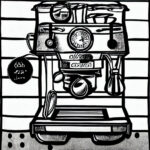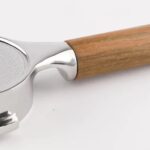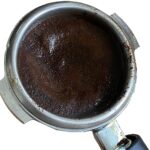Choosing the right portafilter seems a bit tricky these days. Most of the big name commercial grade espresso machines use the classic Faema E61 grouphead with a 58mm portafilter, but not all of them.
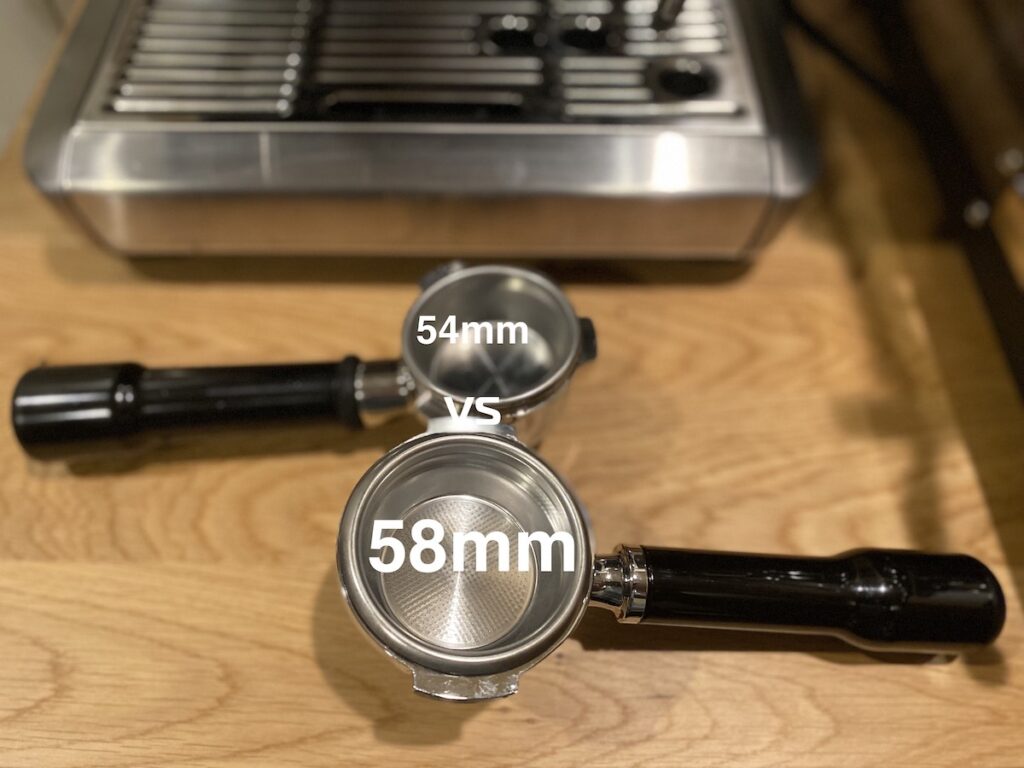
If you look at the lower end consumer or prosumer brands from companies like Breville, they tend to favor the smaller 54mm portafilter for their machines under $1000 and then switch to the 58m for the more expensive machines.
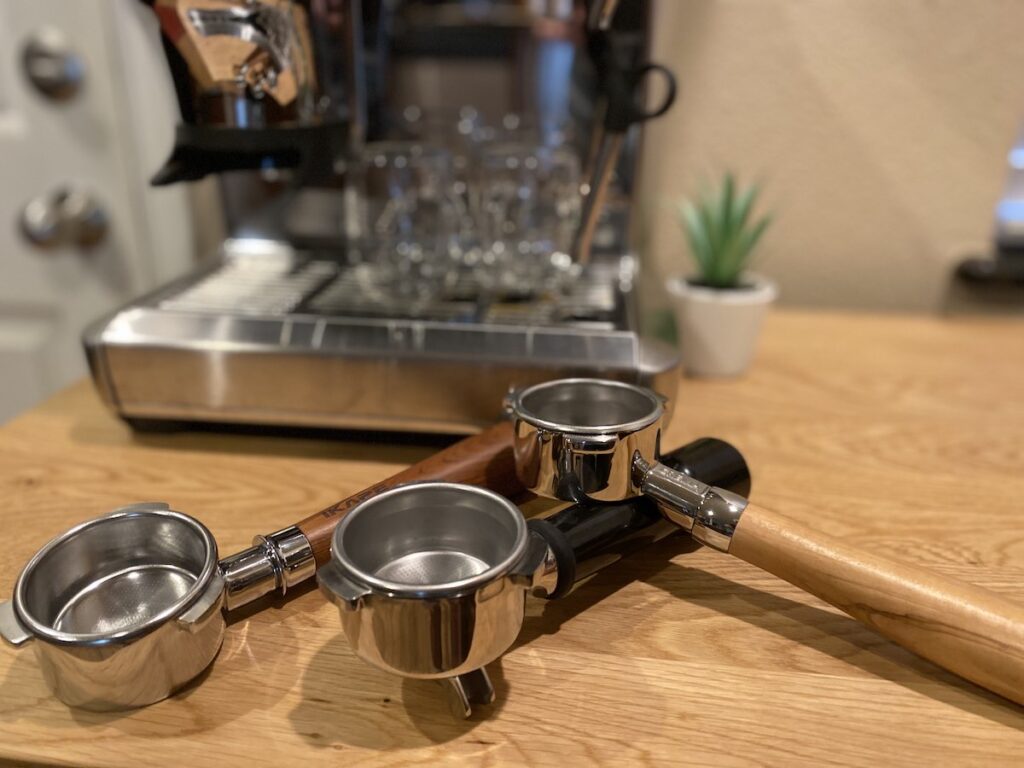
Why Choose A 58mm vs 54mm Portafilter?
One reason why choosing the portafilter size matters, either 58mm or 54mm, is because you will need to buy the same size accessories. 58mm accessories such as tampers, dosing rings, dosing cups, distributors and so forth will not work on 54mm portafilters.
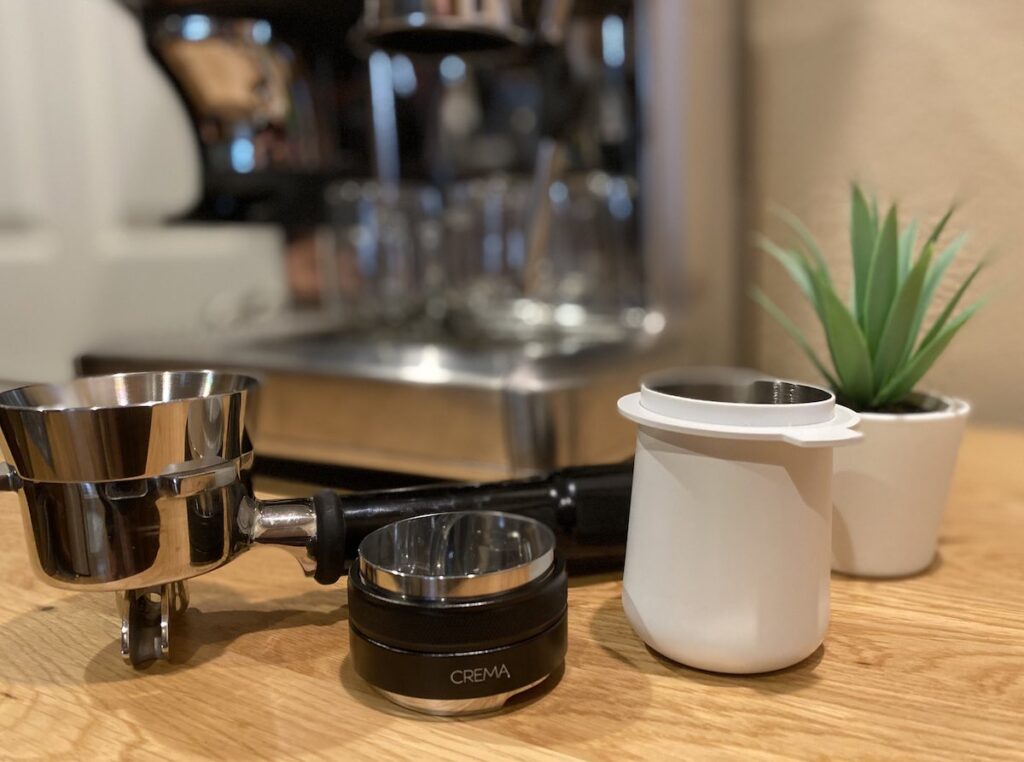
Obviously the espresso machine you buy will dictate the portafilter size, so it is important to know what size you want to work with, not just now, but also in the future. If you see yourself wanting to upgrade from say a consumer or prosumer espresso machine to a commercial grade machine, chances are it will be using 58mm.
When we purchased our first espresso machine, we purchased the Breville Barista Express Impress and it came standard with a 54mm portafilter. So naturally we started picking up 54mm accessories. After doing some research, for us, it seemed 58mm was a better option since most of the more expensive espresso machines used 58mm portafilters.
The advantages and disadvantages of using a 58mm portafilter versus a 54mm portafilter
Portafilters are essential tools in the world of espresso. They hold the coffee grounds, distribute water, and produce that delicious shot of espresso we all love. However, with different sizes available, it’s important to understand the advantages and disadvantages of each. In this article, we’ll compare two popular portafilter sizes: the 58mm and the 54mm.
Advantages of a 58mm portafilter:
- Increased extraction: The larger size allows for more coffee grounds, leading to a higher extraction yield and a stronger, bolder flavor.
- Compatibility: The 58mm size is a more common size, which means that it’s easier to find accessories and replacement parts for it.
- Greater precision: Due to its larger size, it’s easier to distribute the coffee grounds evenly, which can result in a more consistent extraction.
Disadvantages of a 58mm portafilter:
- Longer extraction time: The larger amount of coffee grounds in the basket can result in a longer extraction time, which can lead to over-extraction or a burnt taste.
- Compatibility issues: The 58mm portafilter may not fit on all machines, so it’s important to check compatibility before purchasing.
Advantages of a 54mm portafilter:
- Faster extraction time: The smaller amount of coffee grounds results in a shorter extraction time, which can lead to a sweeter and more delicate flavor.
- More forgiving: The smaller size makes it more forgiving when it comes to tamping and distribution of coffee grounds.
- More compact: A smaller portafilter can be more convenient for home or small cafe use, as it takes up less space.
Disadvantages of a 54mm portafilter:
- Limited availability: Replacement parts and accessories may be harder to find due to the less common size.
- Smaller yield: The smaller size means less coffee grounds, leading to a smaller yield of espresso.
Realistically both the 58mm and 54mm portafilters have their own advantages and disadvantages. If you’re looking for a stronger, bolder flavor and greater precision, a 58mm portafilter may be the way to go. However, if you prefer a sweeter, more delicate flavor and more forgiving tamping, a 54mm portafilter might be the better choice. Ultimately, the decision should be based on your individual preferences and the specific needs of your machine.
Also remember that grind size and the grinder you use (flat burr, conical or blade) can play a huge role in how well the portafilter performs.
Is a 58mm Portafilter better than a 54mm Portafilter?
The larger the portafilter the higher force of extraction occurs within the same pressure giving what many people believe is better consistency in the extraction. Essentially all things being equal, the 58mm diameter allows more of the coffee to be in contact with the water at the bed surface, thus having more direct pressure gradient through the puck.
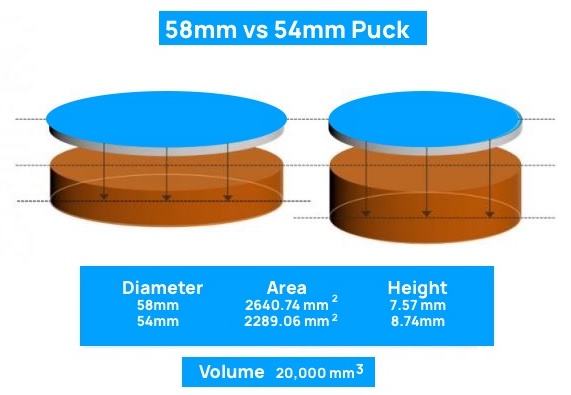
That said, there are companies like Dalla Corte, that feel the 54mm is a better option. They do provide the option with their machines to use a 58mm portafilter as well, but they come equipped using 54mm. Dalla Corte believes that the 54mm size offers more precision and balance in taste. Essentially they believe that since the water has to travel further in the 54mm coffee cake | coffee puck than it would in a 58mm coffee puck ,”Hot water will take longer to drip through the grounded coffee and with less pressure: the result will be a richer and more flavorful coffee.”
The difference between bottomless and spouted portafilters and which one is better?
When it comes to brewing espresso, the portafilter is one of the most critical components of the process. It is the vessel that holds the coffee grounds and determines how water flows through them. A portafilter comes in two types – bottomless and spouted. While both have their unique advantages, it’s important to understand the differences between them and determine which one is better for your needs.
A spouted portafilter is the traditional design most commonly found in commercial and home espresso machines. It features a spout or two, which directs the brewed espresso into the cup. The spouts help control the flow of the espresso, making it easier to pour and prevent splashes. It also makes it easier to measure the exact amount of espresso needed for your drink.
In contrast, a bottomless portafilter is a newer design that has become increasingly popular among coffee enthusiasts. It has no spouts and instead has a hole at the bottom, exposing the espresso as it’s being brewed. This design allows for greater visibility into the brewing process, enabling baristas to see the quality of the extraction and make adjustments as needed. It also allows for more control over the flow of water, which can lead to a better quality espresso shot.
One of the main benefits of using a bottomless portafilter is the ability to diagnose extraction issues. As the espresso is brewed, it flows through the basket and out of the bottom, exposing the extraction process in real-time. This means that any issues with the coffee puck or the grind size can be spotted immediately, allowing adjustments to be made. This level of control is particularly useful for professionals, who are looking to perfect their craft.
On the other hand, the spouted portafilter offers more convenience for the average user. The spouts direct the espresso into the cup, preventing messes and allowing for easy measurement of the exact amount of espresso needed. This is particularly important for those who are making multiple drinks at a time.
When it comes down to it, the decision to use a bottomless or spouted portafilter ultimately comes down to personal preference. Both have their advantages, and the best option for you will depend on your brewing goals and experience. If you’re a professional or experienced home barista, a bottomless portafilter is a great choice for greater control over the brewing process. However, if you’re a casual user who values convenience and simplicity, a spouted portafilter will be the better choice.
The impact of portafilter basket size on espresso extraction and crema.
As any barista knows, the quality of espresso largely depends on the extraction process. It’s no secret that using fresh, high-quality coffee beans and a properly calibrated espresso machine are essential for achieving an excellent shot. However, one of the most overlooked factors in the espresso brewing process is the size of the portafilter basket.
Portafilter baskets come in various sizes, but the most common are 14, 16, 18, and 20-gram baskets. The size of the basket determines how much coffee grounds can be used, which affects the extraction process and the quality of the resulting espresso.
The extraction process relies on a delicate balance of factors, including grind size, water temperature, water pressure, and time. When you use a smaller basket, the coffee grounds are more tightly packed, making it harder for the water to penetrate them. This can result in a slow extraction process and a lower yield of espresso. In contrast, using a larger basket allows for more space between the coffee grounds, which allows for a more even and efficient extraction.
When it comes to crema, the size of the portafilter basket can also play a significant role. Crema is the creamy, frothy layer that forms on top of the espresso shot, and it’s an essential part of the overall taste and appearance of the shot. Using a smaller basket can result in less crema, as the coffee is more tightly packed and the water struggles to pass through the grounds. Conversely, using a larger basket can lead to more crema, as the coffee has more space to expand, creating a more even layer of crema on top of the shot.
Another factor to consider when choosing the size of your portafilter basket is the type of coffee beans you are using. Different coffee beans have different densities, and this can affect the extraction process. For example, lighter-roasted beans are less dense and may require a smaller basket to achieve an even extraction. In contrast, darker-roasted beans are denser and may require a larger basket to extract fully.
Realistically the size of the portafilter basket can have a significant impact on the espresso extraction process and the resulting crema. While there is no one-size-fits-all solution, it’s essential to choose the basket size based on the type of coffee beans you’re using, the desired extraction time, and the amount of crema you want to achieve. Ultimately, experimentation and experience are essential to finding the perfect basket size for your needs, so don’t be afraid to try out different sizes and see what works best for you.
How to troubleshoot common portafilter issues, such as leaks or clogging
As any coffee enthusiast knows, a well-functioning portafilter, be it 54mm or 58mm or any other size for that matter, is essential for producing high-quality espresso shots. However, portafilters can sometimes experience issues such as leaks or clogging, which can affect the taste and quality of your espresso. In this article, we’ll explore some common portafilter issues and how to troubleshoot them.
Leaking portafilter
A leaking portafilter is a common issue that can occur for a variety of reasons. One common cause is a damaged or worn-out gasket. To fix this, you’ll need to replace the gasket with a new one that fits your portafilter. Another possible cause of a leaking portafilter is a loose or damaged spout. In this case, you’ll need to tighten or replace the spout to prevent any further leakage.
Clogged portafilter
If your portafilter is clogged, this can lead to a slow extraction and a weaker espresso shot. One common cause of a clogged portafilter is a buildup of coffee oils and residue. To fix this, you can soak the portafilter in hot water and a cleaning solution specifically designed for coffee equipment. Another solution is to use a cleaning brush to scrub the basket and spout thoroughly.
Difficult to lock in portafilter
If your portafilter is difficult to lock in, this could indicate a problem with the group head. Check to make sure there are no obstructions in the group head that could prevent the portafilter from locking in properly. Another possible cause is a worn-out portafilter spring, which can be easily replaced with a new one.
Uneven extraction
If you’re experiencing an uneven extraction, this could be a sign that your portafilter basket is unevenly packed. To solve this, make sure to distribute the coffee grounds evenly and tamp them down evenly as well. You may also want to experiment with different grind sizes to achieve a more even extraction.
Poor crema
If you’re not getting the desired crema on your espresso shots, this could be due to a variety of factors. One common cause is an uneven extraction, which we just covered in the previous point. Another possible cause is a worn-out portafilter basket or spout. In this case, you’ll need to replace them with new ones.
How many grams fit in 58mm portafilter?
A standard 58mm portafilter basket can hold approximately 18-22 grams of coffee grounds, depending on the roast level, grind size, and other factors. However, it’s important to note that different portafilters and baskets may have slightly different capacities. Additionally, the ideal dose may vary depending on the specific espresso machine and brewing parameters used. It’s generally recommended to experiment with different doses and extraction techniques to find the optimal brew for a particular coffee and equipment setup.
Filter baskets can make a difference in the amount of grams the portafilter can hold. Different filter baskets have different capacities, and some are designed to hold more coffee than others. A larger capacity filter basket will be able to hold more coffee grounds, allowing for a larger shot size. It’s also worth noting that the shape of the filter basket can affect the amount of coffee that it can hold, as well as the way that the coffee extracts.
Here are some common sizes for portafilter baskets:
- 14 grams
- 18 grams
- 20 grams
- 22 grams
- 24 grams
- 25 grams
- 28 grams
- 30 grams
Is A Bigger Portafilter Better?
A bigger portafilter does not necessarily mean it is better. The size of the portafilter depends on the espresso machine and the type of coffee being brewed. Some espresso machines require a specific size of portafilter to work properly. Additionally, the amount of coffee being brewed can also influence the size of the portafilter needed. A larger portafilter may be necessary for brewing multiple shots of espresso at once, but for single shots, a smaller portafilter may be sufficient. Ultimately, the size of the portafilter should be matched to the machine and the brewing needs to ensure the best possible espresso shot.
Portafilter size does have an impact on espresso extraction. While many espresso machines have a standard diameter of 58mm, the depth of the basket is also important. Deeper baskets provide more space for coffee grounds, allowing for a larger volume of espresso to be pulled.
What is industry standard portafilter size?
The standard size for commercial-style portafilters is 58mm, which is widely used in the industry. However, some manufacturers choose to use smaller diameters for pressurized portafilters in their machines. It’s always best to check the specifications of your particular espresso machine to ensure you have the correct size portafilter.
There are some commercial-grade espresso machines that use 54mm portafilters instead of the standard 58mm size. One example is the La Marzocco Linea Mini, which uses a 54mm portafilter. Another example is the Nuova Simonelli Oscar II, which also uses a 54mm portafilter. These machines are designed for smaller coffee shops or home use, where a smaller portafilter may be more practical. However, it’s worth noting that most commercial espresso machines use the standard 58mm portafilter size.
Bottom Line
Obviously troubleshooting common portafilter issues is essential for maintaining the quality of your espresso shots. By identifying and fixing these issues, you can ensure that your equipment is working at its best and producing the highest-quality espresso possible. If you’re experiencing persistent issues or have any concerns about your equipment, don’t hesitate to reach out to a professional for assistance.


